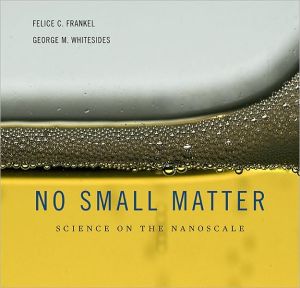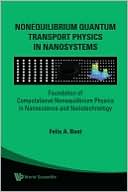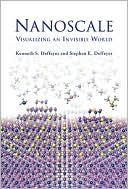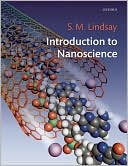No Small Matter: Science on the Nanoscale
A small revolution is remaking the world. The only problem is, we can’t see it. This book uses dazzling images and evocative descriptions to reveal the virtually invisible realities and possibilities of nanoscience. An introduction to the science and technology of small things, No Small Matter explains science on the nanoscale.\ Authors Felice C. Frankel and George M. Whitesides offer an overview of recent scientific advances that have given us our ever-shrinking microtechnology—for instance,...
Search in google:
A small revolution is remaking the world. The only problem is, we can’t see it. This book uses dazzling images and evocative descriptions to reveal the virtually invisible realities and possibilities of nanoscience. An introduction to the science and technology of small things, No Small Matter explains science on the nanoscale.Authors Felice C. Frankel and George M. Whitesides offer an overview of recent scientific advances that have given us our ever-shrinking microtechnology—for instance, an information processor connected by wires only 1,000 atoms wide. They describe the new methods used to study nanostructures, suggest ways of understanding their often bizarre behavior, and outline their uses in technology. This book explains the various means of making nanostructures and speculates about their importance for critical developments in information processing, computation, biomedicine, and other areas. No Small Matter considers both the benefits and the risks of nano/microtechnology—from the potential of quantum computers and single-molecule genomic sequencers to the concerns about self-replicating nanosystems. By making the practical and probable realities of nanoscience as comprehensible and clear as possible, the book provides a unique vision of work at the very boundaries of modern science. Publishers Weekly Starred Review. To follow up their 1997 volume On the Surface of Things: Images of the Extraordinary in Science, scientific photographer Frankel and chemist Whitesides, both of Harvard Univ., present a game, insightful attempt to illustrate reality at the very smallest scales, where lengths are measured in billionths of a meter. Though not all the images are photomicrographic-images like cascading watersteps serve as metaphors for nano- and quantum-scale processes-Frankel's intricate work reveals a world of unexpected textures and landscapes. Whitesides contributes a page each on 60-plus subjects, including everything from "Quantum Cascades" and "Laminar Flow" to "Soap Bubbles" and "Fog" to "Computers as Waterworks" and "Later Flow Assay as Crystal Ball." His text covers the physical, but extends into the metaphysical and, occasionally, the anthropomorphic-"A cell biologist, looking at this structure, can gauge a cell's joie de vivre"-but remains clear throughout, and Frankel provides a helpful appendix describing the techniques she uses to turn invisible science subjects into vibrant art (even out of context, Frankel's photos make a striking exploration of form, line, contrast, shading and motion). This visual and intellectual treat is best absorbed at leisure, with ample time for pondering the new relationships each topic reveals. 100 color illus. Copyright © Reed Business Information, a division of Reed Elsevier Inc. All rights reserved.
\ National PostA book that's elegant in appearance, elegant in its images of the nanoworld and elegant in prose.\ — Robert Fulford\ \ \ \ \ \ NatureReorienting our eye to the nanoscale is No Small Matter. This coffee-table book juxtaposes images and ideas to encapsulate the significance of size and shape… Exploring where art meets science, the authors search for promising paths to make small-scale science more intuitive… Frankel and Whitesides's book adds gravitas and nuance to the popularization of nanotechnology, articulating its interest and vast opportunities.\ — Jeremy Baumberg\ \ \ \ New ScientistWhitesides, a professor at Harvard University, is one of the most productive chemists in the world and arguably one of the most inventive. He brings this spirit to the book, an entertaining jaunt through the world of the micro- and nanoscale. The short essays, each dripping with enthusiasm for the topic, are roughly themed around the importance of scientific endeavour on this scale to such areas as medicine, modern computing and the quantum world. It's not just the text that playfully explores some of the stranger aspects of the invisible world. Frankel's photography can be equally creative, most obviously in a photo of a quantum apple with a shadow that appears to belong to a cube. The pictures are a mix of traditional photography, CGI and images produced using various microscopic techniques, and are dazzling in the best coffee-table tradition. The text is just as vibrant, which makes cover-to-cover reading a slightly exhausting experience—but worth it when it rewards the reader with such gems as why young children at a party behave like cellular molecules, or how Beethoven had much in common with plants.\ — Colin Barras\ \ \ \ \ \ Science NewsSeemingly invisible objects such as viruses and molecules are imaged in rich detail through high-powered microscopes and photography.\ \ \ \ \ \ TechRepublicNo Small Matter: Science on the Nanoscale by Felice C. Frankel and George M. Whitesides shows a world that is beyond our senses and reality. Through text, beautiful pictures, and illustrations, No Small Matter shows the small and (some of) the large things that we are ignorant about or take for granted.\ — Edmond Woychowsky\ \ \ \ \ \ techrepublic.comNo Small Matter: Science on the Nanoscale by Felice C. Frankel and George M. Whitesides shows a world that is beyond our senses and reality. Through text, beautiful pictures, and illustrations, No Small Matter shows the small and (some of) the large things that we are ignorant about or take for granted.\ — Edmond Woychowsky\ \ \ \ \ \ Times Higher EducationNo Small Matter conveys science on the nanoscale through a remarkable series of photographs… This is a brilliant book that will help a wide readership to appreciate the wonders of the very small.\ — Andrew Briggs\ \ \ \ \ \ Publishers WeeklyStarred Review. \ To follow up their 1997 volume On the Surface of Things: Images of the Extraordinary in Science, scientific photographer Frankel and chemist Whitesides, both of Harvard Univ., present a game, insightful attempt to illustrate reality at the very smallest scales, where lengths are measured in billionths of a meter. Though not all the images are photomicrographic-images like cascading watersteps serve as metaphors for nano- and quantum-scale processes-Frankel's intricate work reveals a world of unexpected textures and landscapes. Whitesides contributes a page each on 60-plus subjects, including everything from "Quantum Cascades" and "Laminar Flow" to "Soap Bubbles" and "Fog" to "Computers as Waterworks" and "Later Flow Assay as Crystal Ball." His text covers the physical, but extends into the metaphysical and, occasionally, the anthropomorphic-"A cell biologist, looking at this structure, can gauge a cell's joie de vivre"-but remains clear throughout, and Frankel provides a helpful appendix describing the techniques she uses to turn invisible science subjects into vibrant art (even out of context, Frankel's photos make a striking exploration of form, line, contrast, shading and motion). This visual and intellectual treat is best absorbed at leisure, with ample time for pondering the new relationships each topic reveals. 100 color illus.\ Copyright © Reed Business Information, a division of Reed Elsevier Inc. All rights reserved.\ \ \







